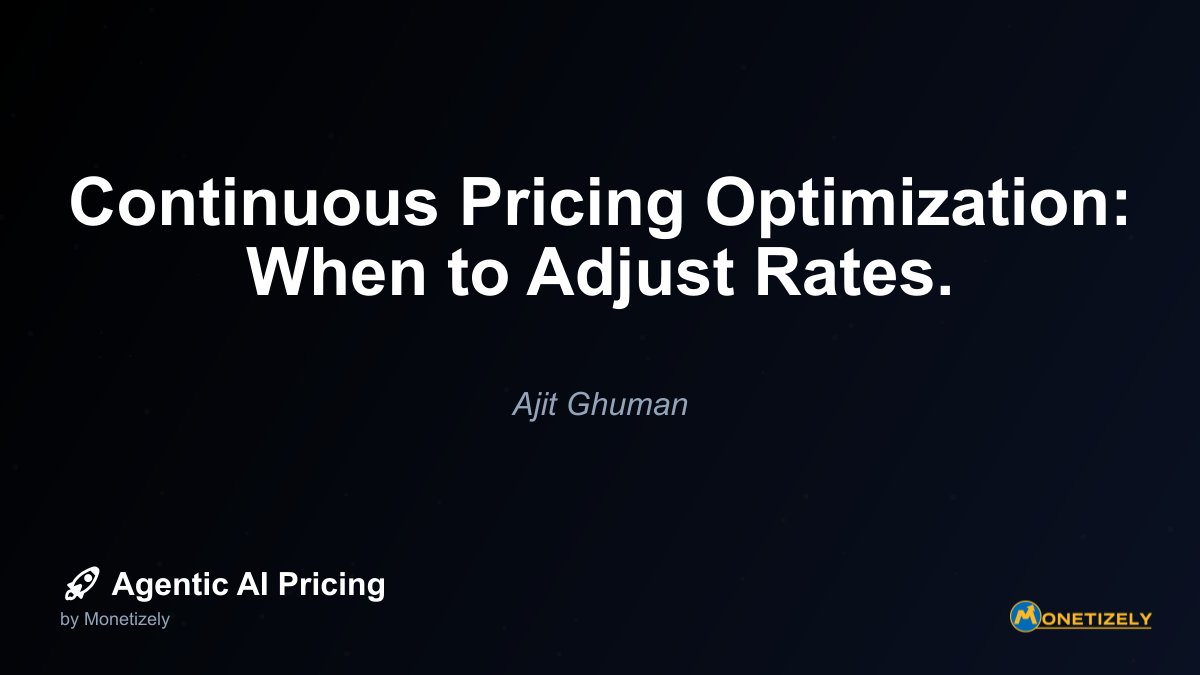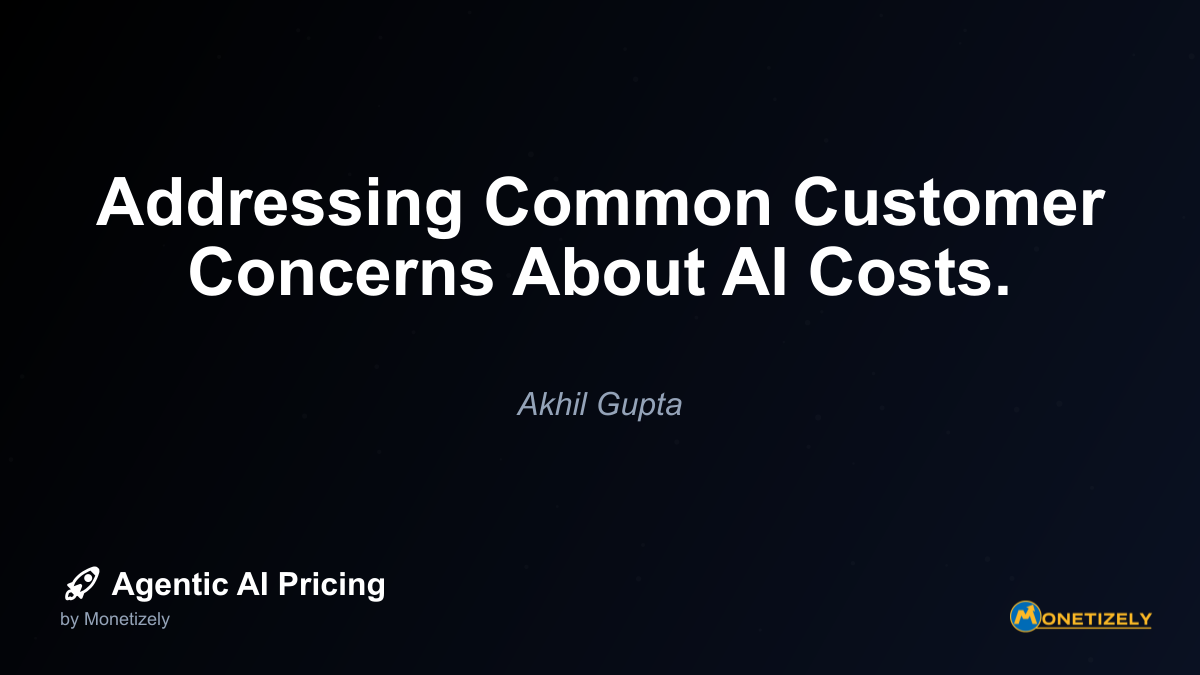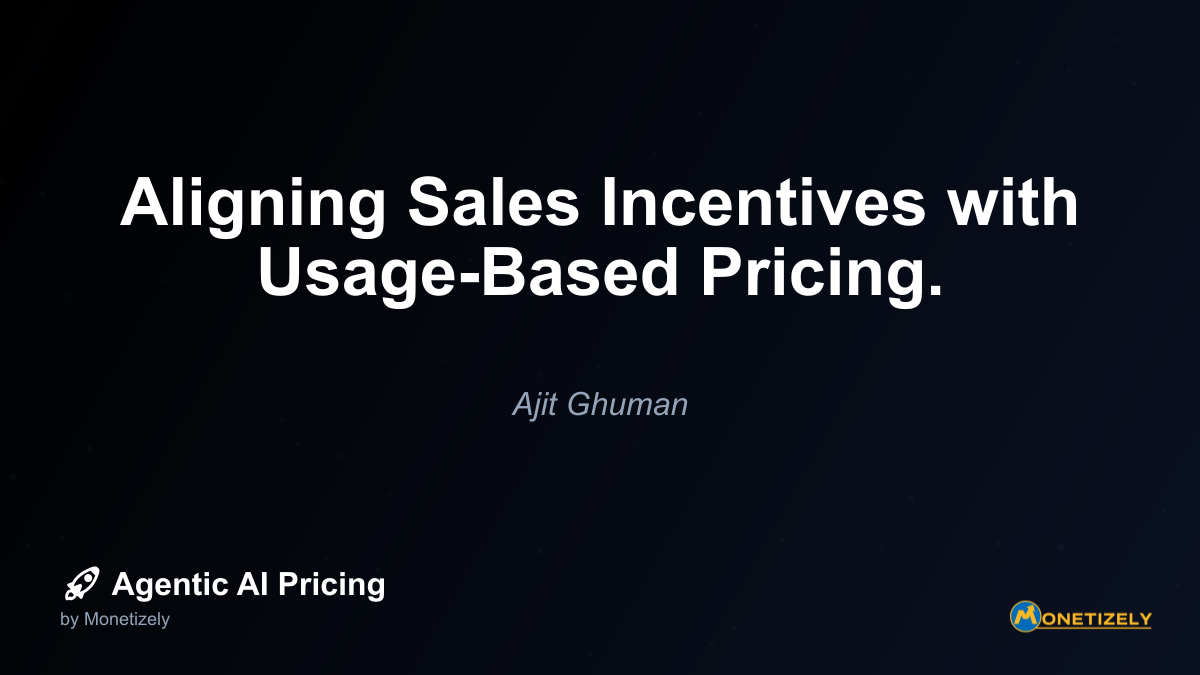· Ajit Ghuman · Best Practices · 6 min read
Continuous Pricing Optimization: When to Adjust Rates.
AI and SaaS Pricing Masterclass
Learn the art of strategic pricing directly from industry experts. Our comprehensive course provides frameworks and methodologies for optimizing your pricing strategy in the evolving AI landscape. Earn a professional certification that can be imported directly to your LinkedIn profile.

Cohort Analysis for Price Sensitivity
Rather than testing multiple price points simultaneously, cohort analysis allows you to examine how different customer segments respond to pricing changes over time.
Implementation approach:
- Segment customers based on acquisition date, industry, size, or other relevant factors
- Implement pricing changes for new customers while maintaining existing rates for current customers
- Compare adoption, usage, and retention metrics across cohorts
- Identify segments with higher or lower price sensitivity
Example: An AI-powered data analytics platform might discover that enterprise customers are relatively price-insensitive compared to SMB customers, leading to a pricing strategy that maximizes margins in the enterprise segment while optimizing for volume in the SMB segment.
Value Metric Recalibration
Sometimes the issue isn’t the price itself but the value metric you’re using to charge customers. Recalibrating your value metric can better align pricing with perceived value.
Implementation approach:
- Analyze usage data to identify metrics that correlate with customer success
- Test alternative pricing structures based on these metrics
- Gather feedback on how well customers understand the new pricing model
- Measure impact on customer acquisition and expansion revenue
Example: An AI customer support agent initially priced per seat might discover that pricing based on resolution rate or conversation volume better reflects the value delivered, particularly as the AI becomes more efficient over time.
Grandfathering vs. Universal Price Changes
When implementing price changes, you’ll need to decide whether to grandfather existing customers at their current rates or implement universal changes.
Grandfathering benefits:
- Maintains goodwill with existing customers
- Reduces immediate churn risk
- Allows for gradual transition to new pricing
Universal change benefits:
- Simplifies pricing administration
- Maximizes immediate revenue impact
- Avoids creating “second-class” customer experiences
The right approach depends on your specific circumstances, including competitive pressure, customer acquisition costs, and the magnitude of the price change.
How to Run Pricing Experiments Without Alienating Customers
Pricing changes can be sensitive, but these approaches can help you optimize without creating customer backlash:
1. Transparent Communication
When testing or implementing price changes, transparency builds trust:
- Explain the rationale behind pricing adjustments
- Highlight additional value customers will receive
- Provide advance notice before significant changes
- Offer migration paths or transition periods
2. Tiered Implementation Strategy
Rather than making sweeping changes, consider a tiered approach:
- Test with a small percentage of new customers first
- Gradually expand to larger segments as you validate results
- Create special offers for early adopters of new pricing models
- Use feedback from initial cohorts to refine your approach
3. Value-Add Price Adjustments
Instead of simply raising prices, couple increases with additional value:
- Add new features or capabilities
- Improve service levels or response times
- Enhance reporting or analytics
- Provide exclusive access to beta features
4. Segmented Pricing Experiments
Not all customers are equally price-sensitive. Segment your experiments based on:
- Customer size or industry
- Historical usage patterns
- Feature utilization
- Geographic region
This approach allows you to identify which segments respond positively to different pricing structures.
Building a Pricing Optimization Framework
To systematize your approach to pricing optimization, establish a framework that includes:
1. Regular Pricing Review Cadence
Set a schedule for comprehensive pricing reviews:
- Quarterly reviews for fast-moving markets
- Semi-annual deep dives for more stable segments
- Annual competitive landscape analysis
- Continuous monitoring of key metrics between formal reviews
2. Pricing Committee Structure
Establish cross-functional ownership of pricing strategy:
- Product leadership to assess feature value
- Finance to analyze margin impacts
- Sales to provide competitive intelligence
- Customer success to share retention insights
- Data science to analyze usage patterns
3. Metrics Dashboard for Pricing Health
Create a dashboard of key metrics to monitor pricing effectiveness:
- Average revenue per user (ARPU)
- Customer acquisition cost (CAC)
- Customer lifetime value (CLV)
- Feature utilization rates
- Price-to-value perception scores from surveys
- Win/loss ratios and reasons
4. Experimentation Protocol
Develop a standardized approach to pricing experiments:
- Minimum viable sample sizes
- Test duration requirements
- Statistical significance thresholds
- Control group management
- Documentation standards
Case Study: Optimizing Pricing for an AI Document Analysis Platform
Consider a hypothetical AI document analysis platform that initially launched with a simple per-document pricing model. After six months in market, the company noticed several signals indicating pricing optimization was needed:
- Enterprise customers consistently processed their document allocation within the first week of each month
- SMB customers rarely used more than 30% of their allocation
- Competitors had begun offering alternative pricing based on page count rather than document count
- Customer feedback indicated frustration with paying the same amount for simple vs. complex documents
The company implemented a multi-phase pricing optimization strategy:
Phase 1: Data Collection and Analysis
- Segmented customers by size, industry, and usage patterns
- Analyzed correlation between document complexity and processing costs
- Surveyed customers about perceived value of different features
- Conducted competitive pricing analysis
Phase 2: Hypothesis Development
- Developed hypothesis that a hybrid model combining base subscription with complexity-adjusted usage would better align with value
- Created financial models projecting revenue impact of various scenarios
- Identified key metrics to monitor during experimentation
Phase 3: Controlled Experimentation
- Implemented A/B testing for new customers, offering either the original or new pricing model
- Maintained existing pricing for current customers while gathering data
- Monitored conversion rates, usage patterns, and customer feedback
Phase 4: Rollout and Iteration
- Based on positive experiment results, rolled out new pricing to all new customers
- Offered existing customers the option to migrate to new pricing or remain on legacy plans
- Continued monitoring key metrics and gathering feedback
- Planned quarterly reviews to further optimize based on emerging data
The result was a 27% increase in average revenue per user while maintaining customer acquisition rates and improving retention among enterprise customers.
Balancing Short-Term Revenue and Long-Term Growth
While pricing optimization can drive immediate revenue gains, it’s essential to balance short-term objectives with long-term growth considerations:
Risk Management Strategies
- Phased Implementation: Roll out changes gradually to minimize disruption
- Escape Hatches: Create pathways back to original pricing if experiments show negative results
- Competitive Monitoring: Watch for competitor responses to your pricing changes
- Customer Sentiment Tracking: Monitor satisfaction scores and feedback during transitions
Long-Term Considerations
- Brand Positioning: Ensure pricing aligns with your desired market position
- Market Development: Consider how pricing affects market education and category creation
- Platform Strategy: Evaluate how pricing supports your broader ecosystem strategy
- Switching Costs: Assess how pricing changes affect customer lock-in and switching costs
Common Pitfalls in Pricing Optimization
Even well-planned pricing optimization efforts can go awry. Here are common pitfalls to avoid:
1. Overreacting to Anecdotal Feedback
Individual customer complaints about pricing may not represent your broader market. Always balance qualitative feedback with quantitative data.
2. Misinterpreting Experimental Results
Short-term conversion improvements might mask long-term retention issues. Ensure your experiments measure impacts across the full customer lifecycle.
3. Complexity Creep
Each pricing iteration risks adding complexity. Regularly assess whether your pricing remains easy to understand and communicate.
4. Competitor-Focused Optimization
While competitive awareness is important, optimizing primarily in reaction to competitors rather than customer value can lead to race-to-the-bottom pricing.
5. Ignoring Implementation Costs
Complex pricing models may require significant engineering resources to implement and maintain. Factor these costs into your optimization decisions.
Conclusion: Continuous Optimization as Competitive Advantage
In the rapidly evolving agentic AI landscape, pricing is never truly “done.” The companies that develop systematic approaches to continuous pricing optimization will gain significant competitive advantage through:
- Better alignment between price and delivered value
- More efficient customer acquisition economics
- Higher customer lifetime value and retention
- Greater ability to capture value as AI capabilities advance
The most successful agentic AI companies view pricing not as a static decision but as a dynamic capability requiring ongoing investment, experimentation, and refinement. By establishing rigorous processes for monitoring pricing effectiveness and methodically testing improvements, you can ensure your pricing strategy evolves alongside your product capabilities and market conditions.
As you implement your own continuous pricing optimization strategy, remember that the goal isn’t simply to extract maximum revenue, but to create pricing that fairly reflects the value you deliver while supporting sustainable growth. When pricing accurately reflects value delivered, both your company and your customers win.
Co-Founder & CEO
Ajit is the author of Price To Scale, a top book on SaaS Pricing and is the Founder of Monetizely. Ajit has led and worked in pricing and product marketing at firms like Twilio, Narvar and Medallia. His work has been featured in Forbes and VentureBeat. Ajit regularly consults with software companies from Seed stage to post-IPO on pricing strategy. Ajit is also a highly-rated co-instructor for 'The Art of SaaS Pricing and Monetization' on Maven.
Pricing Strategy Audit
Let our experts analyze your current pricing strategy and identify opportunities for improvement. Our data-driven assessment will help you unlock untapped revenue potential and optimize your AI pricing approach.




